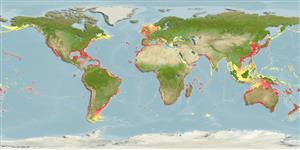Actinopterygii (ray-finned fishes) >
Mugiliformes (Mullets) >
Mugilidae (Mullets)
Etymology: Mugil: Latin, mugil, -ilis = grey mullet (Ref. 45335); cephalus: cephalus meaning head (Ref. 10294). More on author: Linnaeus.
Environment / Climate / Range
Ecology
Marine; freshwater; brackish; benthopelagic; catadromous (Ref. 51243); depth range 0 - 120 m (Ref. 9321), usually 0 - 10 m. Subtropical; 8°C - 24°C (Ref. 4944), preferred 26°C (Ref. 107945); 62°N - 57°S, 180°W - 180°E (Ref. 54241)
Cosmopolitan in coastal waters of the tropical, subtropical and temperate zones of all seas. Eastern Pacific: California, USA to Chile (Ref. 2850). Western Pacific: Japan to Australia (Ref. 9812). Western Indian Ocean: from India to South Africa (Ref. 4393). Western Atlantic: Nova Scotia, Canada to Brazil (Ref. 7251); Cape Cod to southern Gulf of Mexico (Ref. 26938); absent in the Bahamas and most of West Indies and Caribbean (Ref. 7251, 9761). Eastern Atlantic: Bay of Biscay to South Africa, including the Mediterranean Sea and Black Sea (Ref. 7399). Reported in Sea of Okhotsk (Ref. 50550).
Length at first maturity / Size / Weight / Age
Maturity: Lm 35.4, range 30 - ? cm
Max length : 100.0 cm SL male/unsexed; (Ref. 2804); common length : 50.0 cm SL male/unsexed; (Ref. 7399); max. reported age: 16 years (Ref. 28725)
Dorsal
spines
(total): 5;
Dorsal
soft rays
(total): 7-9;
Anal
spines: 3;
Anal
soft rays: 8 - 9. Diagnosis: body stout, cylindrical in cross-section, slightly compressed; head broad and flattened (Ref. 57400). Well developed adipose eyelid (Ref. 40476, 57400) covering most of pupil (Ref. 57400). Upper lip thin and without papillae, armed with 1-6 rows of fine teeth; hind end of upper jaw reaching a vertical line from anterior eye margin; maxillary pad not visible below corner of mouth when closed; origin of 1st dorsal fin nearer to snout tip than to caudal-fin base; anterior parts and bases of 2nd dorsal and anal fins with a moderately dense coverage of scales; pectoral axillary process; 14-15 scale rows between origins of dorsal and pelvic fins (Ref. 57400).
Adults are found in coastal waters (Ref. 2850, 44894, 57400), often entering estuaries and rivers (Ref. 2847, 3573, 11230, 44894, 57400), sometimes far-up-river, lagoons and hypersaline environments (Ref. 57400). They are usually in schools over sand or mud bottom (Ref. 2850), between 0 and 10 m, occurring equally in tropical, subtropical and temperate waters (Project MUGIL). They are mainly diurnal, feeding on detritus, micro-algae and benthic organisms (Ref. 56548, 74902, 74760). Juveniles feed on zooplankton until about 3.0 cm SL (Ref. 59043). Reproduction takes place at sea, at various times of the year depending on the location (Ref. 74907, Amour). There is absence of an obligatory freshwater phase in the life cycle (Ref. 74752). Females spawn 0.8 to 2.6 million eggs which develop at sea (Ref. 74912, Chen & Su 1986). Sexually mature at 3 to 4 years (Ref. 74902). Maximum length reported as 120 cm SL (Ref. 7399, 57400) remains to be confirmed (Project MUGIL). Maximum weight reported as 12 kg (Ref. 56527) seems too high for the area and remains to be confirmed (Project MUGIL). Widely cultivated in freshwater and brackish ponds (Ref. 2847, Jackson 1984, Liao 1981). Marketed fresh, dried, salted, and frozen; roe sold fresh or smoked (Ref. 9321); also used in Chinese medicine (Ref. 12166).
One spawning aggregation was observed in detail. This consisted of five fish, a female and four males. Males would press against the female, which took place as the entire group moved along slowly, facing into a fairly strong tidal flow.
Harrison, I.J., 1995. Mugilidae. Lisas. p. 1293-1298. In W. Fischer, F. Krupp, W. Schneider, C. Sommer, K.E. Carpenter and V. Niem (eds.) Guia FAO para Identification de Especies para lo Fines de la Pesca. Pacifico Centro-Oriental. 3 Vols. FAO, Rome. (Ref. 9321)
IUCN Red List Status (Ref. 115185)
CITES (Ref. 94142)
Not Evaluated
Human uses
Fisheries: highly commercial; aquaculture: commercial; gamefish: yes; bait: occasionally
Tools
Special reports
Download XML
Internet sources
